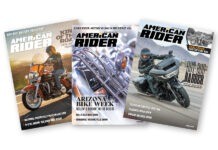
Motorcycles have been a classroom for me most of my life. One of the electives in your motorcycle education can be photography. The man who sold me my first “real” camera over a 30 years ago, J.R. Pat Patterson, has passed at the age of 94. When I bought that first camera from Pat it was in his shop on the main street in our hometown. In later years, he opened Pat’s Camera Cottage along a peaceful stretch of the Neshannock Creek just north of Volant, Pennsylvania. The cottage was quaint, with a screened-in front porch overlooking the creek, a dog and a screen door that could have used some oil. You couldn’t help but slow your pace a bit when you visited Pat at the cottage. I think he knew that. Pat was a wealth of information and ready to help whenever there was a photography crisis. Once, I inadvertently lost my camera bag and its contents off the back of my bike while covering a rally only a week or two before I was scheduled to go to Bonneville. Pat helped me out in choosing new equipment that I had not planned to buy, including replacement lenses suitable for the unique challenges of the Salt Flats. He was like that. It wasn’t uncommon for Pat to go to Florida in the winter but he still took care of business, making sure he got your repairs done and that arrangements were made for you to get your gear back—even if he wasn’t there. I’ll miss Pat, his knowledge and the wonderfully relaxed setting of his shop.
Pat was also a World War II veteran and landed on Utah Beach on D-Day and fought in the Battle of the Bulge, a fate that awaited many D-Day survivors. It’s likely Pat will be the last World War II veteran that I personally know and at a time of year when our focus turns to freedom and independence, it feels right to say “thank you” one more time to Pat and those who have made our freedom possible and gone on to teach us to enjoy the things those freedoms afford, like photography.
You can’t think freedom without thinking Fourth of July and the granddaddy of all Independence Days was our nation’s bicentennial in 1976. If you were around then you know that almost everything was turned out in red, white and blue livery, especially the fire hydrants. About that time, Dad caught the sidecar bug and purchased a Spirit of America, Eagle-model sidecar. This fiberglass beauty featured a 16” wheel, rudimentary swingarm, coil-over suspension and storage behind the seat. Ours didn’t have a roof, but did have a windshield and a spiffy black snap-on tonneau cover to keep cargo dry, and a taillight. If you’ve never had a sidecar, worked on one or ridden in one, you’re missing a chapter in your motorcycling experience.
I recall it hooked up with four adjustable bars, two on the bottom and two diagonals. Those bars clamped onto the bike frame and sidecar frame, then threaded in and out to adjust tracking, toe and camber and were then locked in place once the adjustment was complete. To my recollection, the adjustment was never complete! Much of the perpetual adjustment comes from chasing away what is known as sidecar wobble. Most acknowledged at the time that a bit of this was normal, and largely due to misalignment, but how much was a bit? Tire wear is another peculiarity to be prepared for as the tires on a sidecar rig act more like car tires and wear much differently than a two-wheeler.
Our Spirit of America hack did not escape the tide of patriotism that swept the country in ’76. We laid out a nice circle of blue stars that featured, what else, an American eagle in the center. Our eagle had a golden colonial flair, with an olive branch, gold arrows and red, white and blue bunting clutched tightly in its talons. A sidecar will garner looks regardless of its color, but the 13 stars encircling that eagle made our hack a hit that summer.
The lessons of motorcycling we learn in school sometimes need to be learned again. I was reminded of that when my wife and I were recently caught in a rainstorm with no raingear. A pleasant Sunday ride turned into our weekly bath, when a cold late spring rain poured down on us. We’d been taking a leisurely ride in the country on a nice sunny day, so jeans and tees were the uniform of the day. I’d forgotten to put the raingear back in the bags after cleaning up the bike and truth be told I didn’t think we’d need it anyhow. We got wet, we laughed, we shivered and we poured water out of our boots when we got back home and it all reminded us that the best rain gear is the kind you have with you!


















